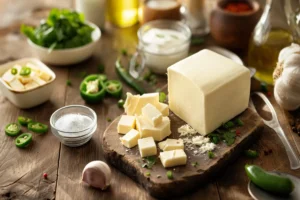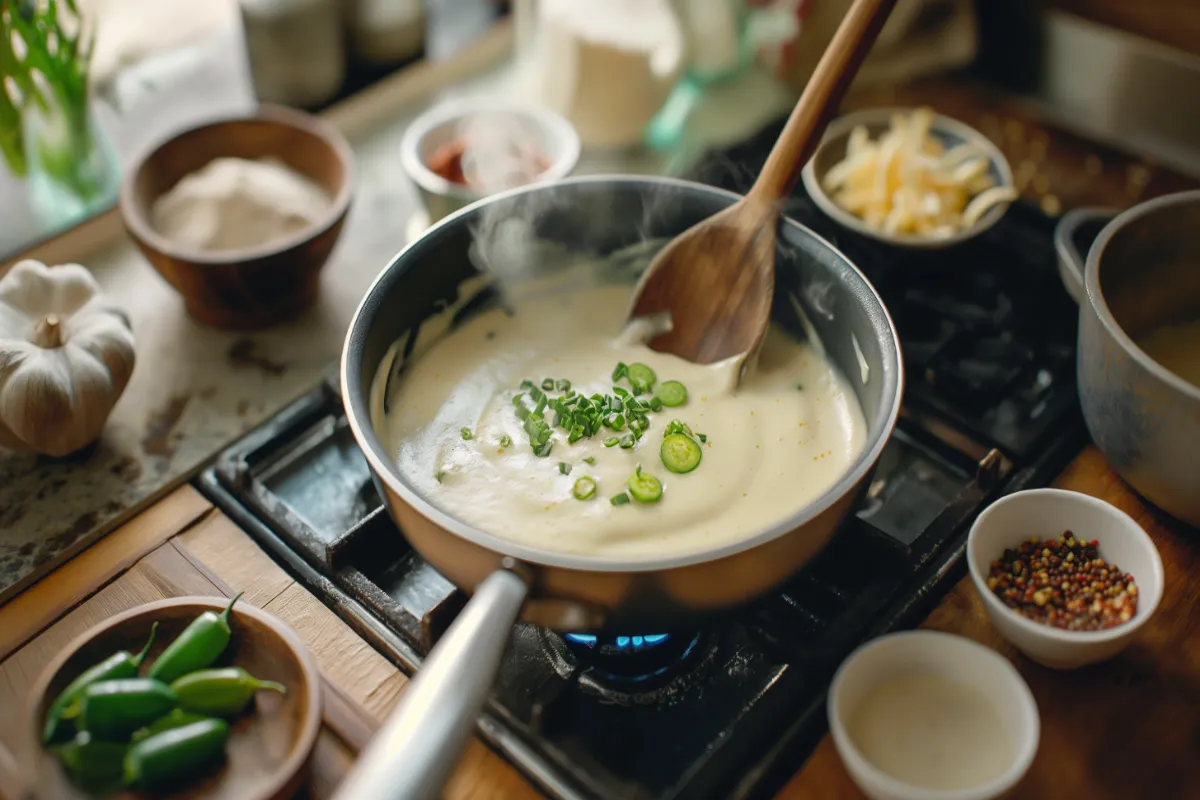Introduction to Queso Blanco Sauce
Queso blanco sauce is a rich, creamy, and flavorful cheese sauce that has become a staple in Mexican and Tex-Mex cuisine. This versatile sauce is known for its mild flavor, smooth texture, and its ability to enhance a wide variety of dishes. Whether used as a dip for tortilla chips, a topping for nachos, or an addition to your favorite Mexican dishes, queso blanco sauce is a beloved ingredient in kitchens everywhere.
But what exactly is queso blanco sauce made of? In this article, we’ll break down the essential ingredients that make this sauce so delicious and explore some variations that can add new dimensions to your recipes. If you’re curious about how queso blanco sauce compares to other similar dishes, check out the difference between queso blanco and queso fresco for more insights.
Core Ingredients in Queso Blanco Sauce
The beauty of queso blanco sauce lies in its simplicity. Made from just a few basic ingredients, this sauce is easy to prepare yet packed with flavor.
1. White American Cheese
- White American cheese serves as the foundational ingredient in queso blanco sauce. This cheese is prized for its smooth melting properties, which create a creamy and cohesive sauce without clumping or separating. Its mild flavor allows the other ingredients to shine, making it the ideal base for this sauce.
2. Milk or Cream
- Milk or cream is used to adjust the consistency of the sauce, making it smooth and pourable. The choice between milk and cream depends on how rich you want the sauce to be. Heavy cream results in a thicker, more indulgent sauce, while milk creates a lighter texture.
3. Green Chilies
- Green chilies add a subtle heat and depth of flavor to queso blanco sauce. These chilies can be fresh or canned, depending on availability and preference. They are essential in giving the sauce its characteristic flavor.
4. Jalapeños (Optional)
- For those who like an extra kick, jalapeños can be added to the sauce. These peppers bring a higher level of heat, which balances out the richness of the cheese and cream.
5. Spices
- Common spices include cumin, garlic powder, and onion powder. These spices enhance the flavor profile of the sauce, adding warmth and complexity.
6. Butter (Optional)
- Butter can be added to increase the richness of the sauce. It adds a smooth, velvety texture that makes the sauce even more indulgent.
Variations in Ingredients

While the core ingredients are relatively consistent, there are numerous ways to customize your queso blanco sauce to suit your taste.
1. Different Cheeses
- Although white American cheese is the most popular choice, you can experiment with other cheeses like Monterey Jack, Mozzarella, or even a blend. Each cheese offers a unique flavor and texture, allowing you to create a sauce that’s perfectly tailored to your preferences. For more ideas on how to blend different types of cheeses, you might find the article on what cheese is not gluten-free insightful.
2. Adjusting Creaminess
- The creaminess of queso blanco sauce can be adjusted by altering the ratio of milk to cream. For a richer sauce, use more cream; for a lighter texture, increase the amount of milk.
3. Fresh Additions
- Fresh ingredients like cilantro or diced tomatoes can add a burst of freshness to the sauce. These additions not only enhance the flavor but also bring vibrant colors and textures to the dish.
The Science Behind Queso Blanco Sauce
Understanding the science behind queso blanco sauce can help you achieve the perfect texture and consistency every time.
1. The Melting Properties of Cheese
- The smooth melting of white American cheese in queso blanco sauce is due to the presence of emulsifiers and proteins that prevent clumping. If you’re interested in the science behind how cheese melts, this guide on melting cheese provides a deeper understanding.
2. The Role of Milk Fat
- The fat content in milk or cream is crucial for creating a rich, creamy sauce. Higher fat content results in a smoother, thicker sauce, while lower fat content can make the sauce thinner and less luxurious.
3. Choosing the Right Cheese
- Not all cheeses melt the same way. Cheeses like white American and Monterey Jack have a higher moisture content, which allows them to melt smoothly and evenly. Cheeses with lower moisture content might not melt as well, potentially leading to a grainy texture.
How to Make Queso Blanco Sauce
Making queso blanco sauce at home is straightforward, but following a few key steps will help you achieve the perfect consistency.
1. Ingredients
- 2 cups of white American cheese, shredded
- 1/2 cup of milk or cream
- 1/4 cup of green chilies, diced
- 1 jalapeño, chopped (optional)
- 1/2 teaspoon of cumin
- 1/2 teaspoon of garlic powder
- 1/2 teaspoon of onion powder
- 1 tablespoon of butter (optional)
2. Instructions
- Heat the Milk or Cream: Begin by heating the milk or cream in a medium-sized saucepan over medium heat until it’s warm but not boiling.
- Add the Cheese: Gradually add the shredded cheese to the warm milk, stirring constantly to ensure it melts smoothly. Adding the cheese slowly helps prevent clumping.
- Incorporate the Chilies and Spices: Once the cheese has melted completely, stir in the green chilies, jalapeños (if using), cumin, garlic powder, and onion powder. Continue stirring until the sauce is smooth and well-blended.
- Optional Step: For an even richer sauce, stir in the butter until it’s fully melted.
- Serve: Transfer the sauce to a serving bowl and enjoy it with tortilla chips, drizzled over nachos, or as a topping for your favorite dishes.
Serving Suggestions
This cheese sauce is incredibly versatile, making it a fantastic addition to many dishes. Here are some ideas on how to serve it:
1. Traditional Uses
- As a Dip: Serve this creamy sauce with tortilla chips for a classic appetizer.
- Over Nachos: Drizzle the sauce over nachos, adding toppings like jalapeños, guacamole, and sour cream for a loaded experience.
- As a Topping: Use it to top tacos, burritos, or enchiladas, adding a rich, creamy element to these dishes.
2. Creative Ideas
- On Baked Potatoes: Pour the sauce over baked potatoes for a decadent, cheesy treat.
- In Burgers: Add a spoonful of the sauce to burgers for an extra layer of flavor.
- As a Vegetable Dip: Serve it as a dip for fresh vegetables like carrots, celery, and bell peppers.
3. Pairing with Drinks
- This versatile sauce pairs wonderfully with a variety of drinks, including margaritas, cold beers, or iced tea. The rich, creamy texture complements the refreshing qualities of these beverages.
Nutritional Information and Health Considerations
While this cheese dip is undeniably delicious, it’s important to be mindful of its nutritional content, especially if you’re watching your diet.
1. Caloric Content and Macronutrient Breakdown
- The calorie content can vary depending on the ingredients used. On average, a serving can range from 100 to 200 calories, with a balance of fats and proteins. The richness of the sauce comes primarily from the fat content in the cheese and cream.
2. Making a Lighter Version
- If you’re looking to reduce the calorie count, consider making a lighter version by using low-fat cheese and milk instead of cream. While the sauce may not be as rich, it will still be flavorful and satisfying.
3. Health Benefits and Drawbacks
- This sauce is a good source of calcium and protein, both of which are essential for maintaining healthy bones and muscles. However, it can also be high in fat and sodium, so it’s best enjoyed in moderation. Pairing the sauce with healthier options like fresh vegetables can help balance out its richness.
Storing and Reheating
If you have leftover sauce, proper storage and reheating are key to maintaining its texture and flavor.
1. Storing Leftovers
- Store any leftover sauce in an airtight container in the refrigerator, where it should keep for up to four days. Be sure to let the sauce cool completely before sealing it to prevent condensation from affecting its texture.
2. Reheating Tips
- To reheat the sauce, warm it gently on the stovetop over low heat, stirring frequently. If the sauce is too thick, add a splash of milk or cream to restore its creamy texture. Alternatively, you can reheat it in the microwave in short bursts, stirring between each burst until it’s heated through.
3. Freezing the Sauce
- Freezing this cheese dip is generally not recommended, as it can become grainy upon thawing. However, if you must freeze it, thaw it in the refrigerator overnight and reheat it slowly, adding cream or milk as needed to smooth out the texture.
Common Questions
1. What is this sauce made of?
- The sauce is typically made from white American cheese, milk or cream, green chilies, and spices like cumin, garlic powder, and onion powder. Some variations also include jalapeños and butter for added richness.
2. Can you make it without processed cheese?
- Yes, you can make this cheese dip without processed cheese by using a combination of fresh cheeses like Monterey Jack and mozzarella. Just be sure to melt them slowly to avoid clumping.
3. Why is my sauce grainy?
- Graininess can result from overheating the cheese or using cheeses that don’t melt smoothly. To avoid this, melt the cheese slowly over low heat and use cheeses that are known for their melting properties.
4. How can I make it spicier?
- To add more spice, you can include additional jalapeños, hot sauce, or even chopped chipotle peppers. Experiment with different spices like cayenne or smoked paprika to find your preferred level of heat.
5. Is this the same as queso fresco?
- No, this cheese sauce and queso fresco are not the same. The former is a melted cheese sauce, while queso fresco is a crumbly, fresh cheese often used as a topping for various dishes. For more details, see the difference between the two types of cheese.
Conclusion
This versatile cheese dip is a delicious addition to any meal. Whether you’re serving it as a dip with tortilla chips, drizzling it over nachos, or using it as a creamy topping for your favorite Mexican dishes, this sauce is sure to be a hit. With the information provided in this guide, you can now create your own version of this classic sauce at home, experimenting with different ingredients and techniques to make it truly your own.


1 thought on “What Is Queso Blanco Sauce Made Of?”